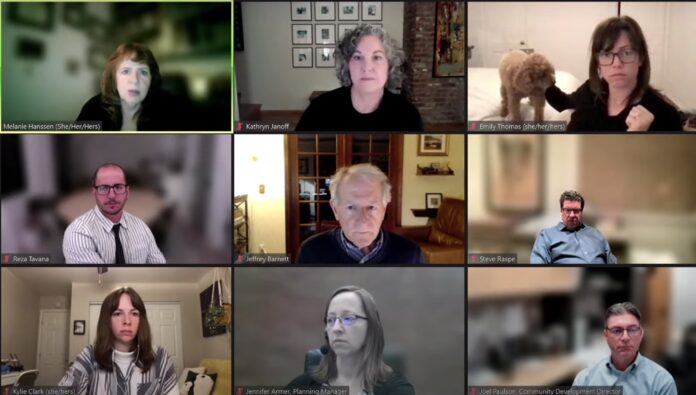
Despite clear divisions in planning commissioner thinking over the critical question of future housing in town, on Monday they ultimately managed to agree—in a unanimous 7-0 vote—on how to reduce development targets.
In addition to removing 313 units of potential residential development from the office and service commercial zones, they decided to recommend Council shave low density residential down to 10 units per acre and whittle medium density residential to either 20 or 22 units per acre (depending on whichever brings the total to 500 parcels).
At their previous meeting, April 27, an earlier attempt to come together on this sticky point failed 3-3, since Commissioner Reza Tevana was absent.
Commissioners Emily Thomas and Kylie Clark took up pro-housing positions and challenged fears tied to creating new opportunities for developers; Commissioner Steve Raspe joined Vice Chair Jeffrey Barnett in advocating for a massive reduction in the number of units to recommend Council allow to be built in several areas—particularly for single-family properties; meanwhile, Chair Melanie Hanssen and Commissioner Kathryn Janoff attempted to carve out a middle ground that would appease vocal homeowners worried about the effects of growth, while scanning for a path to consensus.
But such consensus remained elusive.
Janoff said commissioners should make recommendations in a “prudent” and “thoughtful” manner, and to take into consideration the hard work of the General Plan Advisory Committee.
“I understand why the number in the current Draft General Plan is what it is,” she said, adding she’s also been listening to feedback from locals, but then corrected herself. “It’s more than feedback—it’s more like uproar.”
It’s important to remember that the General Plan lasts for 20 years, she said, meaning it has to factor in three different Regional Housing Needs Assessment housing cycles. That’s the number of housing units the State asks each community to plan for.
Under the Draft, staff sketched out projections for 2,763 units of new housing, 500 accessory dwelling units (ADUs), and 475 projects already in the pipeline—so 3,737 units over the next two decades.
Los Gatos has been told it has to plan for 1,993 housing units in just the next eight years—much of it for lower-income people—as California struggles to catch up after years where wealthy communities, such as in Silicon Valley and Beverly Hills, didn’t do their part to make sure people could afford a roof over their head.
Some groups, such as the Los Gatos Community Alliance, say even if Los Gatos plans for 3,737 units, there could be more development beyond that, as homeowners start to take advantage of new laws meant to spur housing production.
They also argue the upcoming 1,993 RHNA figure (plus a 15% buffer, which brings the total to 2,292) is just a blip meant to take care of a temporary affordability crisis, and that Los Gatos can soon go back to a more familiar, much lower, requirement.
Housing advocates say this is unlikely, considering how many communities across the state are either refusing or failing to meet their allotments.
“I do think just one problem we’ve had so far is misinformation,” said Clark, who also works at nonprofit West Valley Community Services, which provides resources to low-income residents. “I heard people say we’re going to build 30,000 units. It did get really inflated.”
One point of agreement, she said, could be that both pro-housing and anti-growth factions want the Housing Element—which provides for the RHNA numbers—to get approved by the State, instead of getting caught up in legal battles and potentially losing control of development in town altogether. Los Gatos is already saving money because it didn’t fight the 1,993 figure, an approach attempted unsuccessfully by many municipalities, she said.
Santa Monica was told to plan for 8,895 housing units (including 6,168 affordable), but its Housing Element was rejected after the State decided officials hadn’t done enough to create housing opportunities for people of lesser means.
The Los Gatos Community Alliance has been urging elected officials to leave single family homeowners alone and concentrate affordable housing in areas already zoned for higher density.
Barnett said he thinks Los Gatos should cut the number of homes it plans to build and reconsider things every five years.
He pitched a 100% reduction (or, 279 units) in the number of increased housing to the low-density category, which commissioners noted is where the majority of opposition to the current plan has come from.
He also suggested a 50% reduction in the increase to medium-density residential (a 165-unit drop), as well as having the increase in the central business district (which would total 67 fewer units there). He also said Los Gatos should reduce the number in community commercial and neighborhood commercial by 58.
Raspe indicated he was generally in alignment with Barnett’s proposal.
Thomas made it clear she wasn’t going to go along with a plan where single-family home lots are exempt from contributing to the Town’s affordable housing stock.
‘Naturally, smaller units cost less; i think we really can count on that’
—Kylie Clark, planning commissioner
“We all have to be responsible for trying to increase low-income housing,” she said.
Clark said allowing fourplexes on low density lots will, by definition, create cheaper housing.
“Just because you live in a single-family neighborhood shouldn’t mean you’re immune to these changes,” she said. “Naturally, smaller units cost less; I think we really can count on that.”
Janoff said she understands the argument for keeping rules for single family home properties as-is.
“It seems to be popular among those who are most concerned,” she said, but added she’s worried reverting to the 2020 General Plan density for this cohort would prevent a range of intermediate housing options, called “missing middle housing” from taking root. “It’s a very important concept.”
Thomas said the Town should promote “missing middle” housing to encourage developers to build in this format, which allows local officials to review plans and hear from neighbors, as opposed to digging in its heels on the low-density zoning. This way, builders could be steered away from going the so-called SB 9 lot-split route—where developers could automatically secure approval and might result in a whack of ugly, density-capitalizing homes going up around town, she said.
Hanssen said she’s uncomfortable reverting to current densities in any category and suggested spreading growth around, as opposed to concentrating housing in one area, will actually help with traffic problems.
“While I’m kind of not on one side or the other…I wouldn’t be comfortable going to zero change in any zone,” she said.
It was Janoff who made the motion to shave off 313 units from the housing target, pulling from office and service commercial, as well as to pull back a bit on low density residential increases—but only if “missing middle” homes could still be built in these parts of town.
Staff confirmed densities would still have to go up enough to allow for fourplexes.
Clark seconded the motion.
Janoff, Hanssen and Clark voted for the motion, while Raspe, Thomas and Barnett voted against, so it died.
Clark tried another motion just focusing on the apparent agreement on community commercial and neighborhood commercial, but ultimately withdrew it.
Instead, the commission directed staff to crunch the numbers on how much they could reduce low density residential numbers while still encouraging “missing middle housing” in town, and continued the matter to May 2.
That number-crunching revealed that 10 units per acre seemed to be the magic number around which building fourplexes and other “missing middle” homes in low density neighborhoods would still be possible, so commissioners’ positions finally began to coalesce. Raspe said he’d prefer a drop down to eight units per acre, but was persuaded up a couple density points—just as Clark had been coaxed downwards a couple, after learning this would still allow fourplexes on 12% (or 831) of low density parcels. They chose 20 or 22 units per acre for medium density residential, because staff said—even with this density increase—only somewhere between 11%-21% of these lots (354-708 parcels) could fit fourplexes.
Clark made the motion, with Barnett seconding it.
“See. We did it,” Hanssen said. “We got consensus.”
Janoff made the motion to move the entire Draft General Plan on to Council, with all the changes they’d suggested. This, too, was also approved unanimously.









